Meiji Memorial Picture Gallery
Meiji Memorial Picture Gallery (聖徳記念絵画館, Seitoku Kinen Kaigakan) opened in Tokyo, Japan, in 1926. In June 2011, the Gallery was designated an Important Cultural Property. Inside are eighty paintings depicting events from the life of Emperor Meiji, by forty leading nihonga and forty leading yōga artists.[1][2][3]
| Meiji Memorial Picture Gallery | |
|---|---|
聖徳記念絵画館 | |
 | |
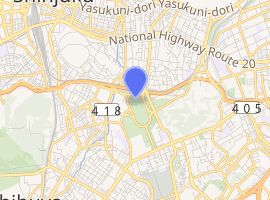
| |
| General information | |
| Address | 1-1 Kasumigaoka-machi |
| Town or city | Shinjuku, Tokyo |
| Country | Japan |
| Coordinates | 35°40′44″N 139°43′04″E |
| Opened | 1926 |
| Website | |
| Official website | |
Wall art collections are displayed to show the events from the birth to the demise of the Meij'i Emperor in chronological order, with the titles of the works representing the events. The first 40 works are Japanese-style paintings, while the later 40 are Western-style works. The pictures, each measuring about 3m x 2.7m.[4]
The building was designed by architect Masatsugu Kobayashi and completed on 22 October 1926.[5] Kobayashi's design was chosen from 156 entries in a public design competition held in 1918. His original drawing was modified by Meijijingu Zoeikyoku (building department).[4]
| Painting | Date of event | Painter | Dedication of painting | Comments | Image | Dedicator | |
|---|---|---|---|---|---|---|---|
| 1 | The Birth of Emperor Meiji 御降誕 Go-kōtan | 3 November 1852 | Takahashi Shūka (高橋秋華) (1877–1953) | July 1930 | depicted is the Lying-in Chamber (御産室) erected by Nakayama Tadayasu in the grounds of Kyoto Imperial Palace | .jpg) | Marquis Nakayama Sukechika (中山輔親) |
| 2 | The Rites of Growth 御深曾木 On-fukasogi | 6 May 1860 | Kitano Tsunetomi (北野恒富) (1880–1947) | November 1934 | ceremonial trimming of the hair, performed by Ichijō Tadaka (一条忠香) in the Omima | .jpg) | Baron Kōnoike Zenemon (鴻池善右衛門) |
| 3 | Investiture of the Crown Prince 立親王宣下 Ritsu shinnō senge | 10 November 1860 | Hashimoto Eihō (橋本永邦) (1886–1944) | June 1931 | Nijō Nariyuki presents the imperial proclamation at the Palace | .jpg) | Mitsubishi Gōshi gaisha |
| 4 | Accession to the Throne 践祚 Senso | 13 February 1867 | Kawasaki Shōko (川崎小虎) (1886–1977) | August 1930 | the Emperor, aged fifteen, appointed Nijō Nariyuki as regent in the Seiryōden on the day of his accession | (not public domain until 2047) | Marquis Ikeda Nobumasa (池田宣政) |
| 5 | Resignation of the Last Shōgun 大政奉還 Taisei hōkan | 7 November 1867 | Murata Tanryō (邨田丹陵) (1872–1940) | October 1935 | Tokugawa Yoshinobu informs officials of his decision at Nijō-jō | 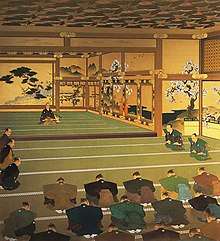 | Prince Tokugawa Yoshimitsu (徳川慶光) |
| 6 | Restoration of Imperial Rule 王政復古 Ōsei-fukko | 3 January 1868 | Shimada Bokusen (島田墨仙) (1867–1943) | March 1931 | the Emperor abolishes the offices of Sesshō, Kampaku, and Shōgun | .jpg) | Marquis Matsudaira Yasutaka (松平康荘) |
| 7 | The Battles of Toba and Fushimi 伏見鳥羽戦 Fushimi-Toba-sen | 29 January 1868 | Matsubayashi Keigetsu (松林桂月) (1876–1963) | July 1933 | .jpg) | Prince Mōri Motoaki (毛利元昭) | |
| 8 | Attainment of Majority Ceremony 御元服 Go-genpuku | 8 February 1868 | Itō Kōun (伊東紅雲) (1880–1939) | November 1928 | held shortly after the Emperor turned 16; his hairstyle was changed, he donned the robes of manhood, and he was crowned by Prince Fushimi Kuniie | .jpg) | Prince Konoe Fumimaro |
| 9 | The Emperor's Visit to the Dajōkan 二条城太政宮代行幸 Nijō-jō Dakōjan dai-gyōkō | 25 February 1868 | Kobori Tomoto (小堀鞆音) (1864–1931) | April 1933 | the Emperor was conveyed to Nijō-jō by palanquin | .jpg) | Baron Mitsui Hachirōemon |
| 10 | The Imperial Army Leaves Kyōto 大総督熾仁親王京都進発 Dai-sōtoku Taruhito shinnō Kyōto shinpatsu | 8 March 1868 | Takatori Wakanari (高取稚成) (1867–1935) | September 1931 | Prince Arisugawa Taruhito salutes the Emperor in front of the Kenreimon before setting out for Edo | .jpg) | Marquis Hachisuka Masaaki (蜂須賀正韶) |
| 11 | The Emperor Receives Foreign Ministers 各国公使召見 Kakkoku kōshi shōken | 23 March 1868 | Hiroshima Kōho (広島晃甫) (1889–1951) | November 1930 | the Emperor receives Dirk de Graeff van Polsbroek; to the left and right of the imperial dais are Prince Yamashina Akira and Iwakura Tomomi | .jpg) | Marquis Date Muneharu (伊達宗彰) |
| 12 | Proclamation of the Imperial Oath 五箇條御誓文 Gokajō no go-seimon | 6 April 1868 | Inui Nanyō (乾南陽) (1870–1940) | April 1928 | Sanjō Sanetomi reads the Oath in Five Articles | .jpg) | Marquis Yamauchi Toyokage (山内豊景) |
| 13 | The Surrender of Yedo Castle 江戸開城談判 Edo kaijō danpan | 6 April 1868 | Yūki Somei (結城素明) (1875–1957) | December 1935 | Saigō Takamori and Katsu Kaishū negotiate the surrender without bloodshed of Edo Castle | .jpg) | Marquis Saigō Michinosuke (西郷吉之助), Count Katsu Kuwashi (勝精) |
| 14 | The Emperor Reviewing Clan Warships 大阪行幸諸藩軍艦御覧 Ōsaka gyōkō shohan gunkan goran | 18 April 1868 | Okada Saburōsuke (1869–1939) | April 1936 | in Ōsaka Bay | .jpg) | Marquis Nabeshima Naomitsu (鍋島直映) |
| 15 | Enthronement of the Emperor 即位礼 Sokui no rei | 12 October 1868 | Igai Shōkoku (猪飼嘯谷) (1881–1939) | December 1934 | in the grounds of Kyōto Imperial Palace | .jpg) | Kyōto City |
| 16 | The Emperor Viewing Rice Harvest 農民収穫御覧 Nōmin shūkaku goran | 11 November 1868 | Morimura Gitō (森村宜稲) (1872–1938) | August 1930 | in Hatchōnowate (八丁畷), Owari Province, while en route to Tōkyō | .jpg) | Marquis Tokugawa Yoshichika (徳川義親) |
| 17 | The Emperor Arriving in Tōkyō 東京御着輦 Tōkyō go-chakuren | 26 November 1868 | Kobori Tomoto (小堀鞆音) (1864–1931) | October 1934 | arrival at Edo Castle | .jpg) | Tōkyō City |
| 18 | Installation of the Empress 皇后冊立 Kōgō no sakuritsu | 9 February 1869 | Suga Tatehiko (菅楯彦) (1878–1963) | December 1935 | Princess Haruko arrived at the Kyōto Imperial Palace in the traditional ox-cart | .jpg) | Ōsaka City |
| 19 | The Emperor at the Grand Shrine of Ise 神宮親謁 Jingū shinetsu | 23 April 1869 | Matsuoka Eikyū (松岡映丘) (1881–1938) | April 1927 | the Emperor left Kyōto for Tōkyō for the second time on 8 April 1869, stopping en route at Ise Jingū | 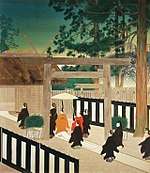 | Marquis Ikeda Nakahiro (池田仲博) |
| 20 | The End of the Feudal Clans 廃藩置県 Haihan chiken | 29 August 1871 | Kobori Tomoto (小堀鞆音) (1864–1931) | September 1931 | Sanjō Sanetomi reads the edict | 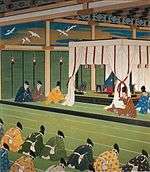 | Count Sakai Tadamasa (酒井忠正) |
| 21 | The Iwakura Mission to America and Europe 岩倉大使欧米派遣 Iwakura taishi Ōbei haken | 23 December 1871 | Yamaguchi Hōshun (1893–1971) | December 1934 | the party board the steamship SS America in the Port of Yokohama | (not public domain until 2041) | Yokohama City |
| 22 | The Great Imperial Thanksgiving Rite 大嘗祭 Daijō-sai | 28 December 1871 | Maeda Seison (1885–1977) | July 1933 | performed once by each emperor; the Emperor offers up newly harvested rice and sake | (not public domain until 2047) | Count Kamei Koretsune (亀井茲常) |
| 23 | Imperial Tour of Chūgoku and Kyūshū (Entering Nagasaki Port) 中国西国巡幸(長崎御入港) Chūgoku Saikoku junkō (Nagasaki go-nyūkō) | 19 July 1872 | Yamamoto Morinosuke (山本森之助) (1877–1928) | December 1928 | aboard the ironclad Ryūjō | .jpg) | Nagasaki City |
| 24 | Imperial Tour of Chūgoku and Kyūshū (The Emperor in Kagoshima) 中国西国巡幸(鹿児島着御) Chūgoku Saikoku junkō (Kagoshima chakugyo) | 27 July 1872 | Yamanouchi Tamon (山内多門) (1878–1932) | November 1930 | the imperial entourage enters the Shimazu residence, where the Emperor stayed nine days | .jpg) | Kagoshima City |
| 25 | Opening of the Tokyo-Yokohama Railway 京浜鉄道開業式行幸 Keihin tetsudō kaigyō-shiki gyōkō | 14 October 1872 | Komura Daiun (小村大雲) (1883–1938) | June 1935 | the Emperor arrives at Shimbashi Station by carriage before proceeding to Yokohama Station by train | .jpg) | Ministry of Railways |
| 26 | Establishment of the Ryūkyū Clan 琉球藩設置 Ryūkyū-han setchi | 3 March 1873 | Yamada Shinzan (山田真山) (1885–1977) | December 1928 | in 1872 Shō Tai, last king of the Ryūkyū Kingdom, sent an envoy to Tōkyō; the ship is shown returning to Naha | (not public domain until 2047) | Shuri City |
| 27 | The Emperor Reviewing Military Manoeuvres 習志野之原演習行幸 Narashino-no-hara enshū gyōkō | 29 March 1873 | Koyama Eitatsu (小山栄達) (1880–1945) | September 1929 | on the Narashino Plain in Chiba Prefecture | .jpg) | Marquis Saigō Jūtoku (西郷従徳) |
| 28 | The Empress at a Silk Factory 富岡製糸場行啓 Tomioka seishijō gyōkei | 24 June 1873 | Arai Kampō (1878–1945) | February 1933 | Empress Shōken and Empress Dowager Eishō visit Tomioka Silk Mill | .jpg) | Dainichi Silkworm Society (大日蚕糸会) |
| 29 | The Emperor Drilling Soldiers 御練兵 Go-renbei | 1874 | Machida Kyokukō (町田曲江) (1879–1967) | November 1928 | on the grounds of the Akasaka Temporary Palace | .jpg) | Jūgo Bank (十五銀行) |
| 30 | His Majesty at Lecture 侍講進講 Jikō shinkō | 1874 | Dōmoto Inshō (1891–1975) | October 1934 | Motoda Nagasane (元田永孚) lectures to the Emperor | (not public domain until 2045) | Bank of Taiwan |
| 31 | The Emperor on a Personal Visit 徳川邸行幸 Tokugawa-tei gyōkō | 4 April 1875 | Kimura Buzan (1876–1942) | December 1930 | while viewing cherry blossoms at the residence of Tokugawa Akitake, the Emperor composed a tanka in honour of the loyalty of his host's forebears Tokugawa Mitsukuni and Tokugawa Nariaki | .jpg) | Prince Kuniyuki Tokugawa |
| 32 | The Empress Viewing Rice-Planting 皇后宮田植御覧 Kōgō-miya taue goran | 18 June 1875 | Kondō Shōsen (近藤樵仙) (c.1866–1951) | December 1927 | in the grounds of the Akasaka Temporary Palace | .jpg) | Prince Ichijō Sanetaka (一条実孝) |
| 33 | The First Conference of Governors 地方官会議臨御 Chihōkan kaigi ringyo | 20 June 1875 | Isoda Chōshū (磯田長秋) (1880–1947) | January 1928 | .jpg) | Marquis Kido Kōichi | |
| 34 | The Empress at a School for Girls 女子師範学校行啓 Joshi shihan gakkō gyōkei | 29 November 1875 | Yazawa Gengetsu (矢沢弦月) (1886–1952) | April 1934 | the Empress attends the opening ceremony of Tokyo Normal School for Girls | .jpg) | group Ōinkai (桜蔭会) |
| 35 | The Emperor Inspecting Horses 奥羽巡幸馬匹御覧 Ōu junkō bahitsu goran | 7 July 1876 | Neagari Tomiji (根上富治) (1895–1981) | October 1934 | at Morioka Hachimangū | (not public domain until 2051) | Nippon Kangyō Bank (日本勧業銀行) |
| 36 | The Imperial Mausoleum at Unebi 畝傍陵親謁 Unebi-ryō shinetsu | 11 February 1877 | Yoshida Shūkō (吉田秋光) (1887–1946) | January 1932 | the Emperor worships at the mausoleum of Emperor Jimmu at Unebi | .jpg) | Baron Sumitomo Kichizaemon (住友吉左衛門) |
| 37 | The Siege of Kumamoto Castle 西南役熊本籠城 Seinan-eki Kumamoto rōjō | March 1877 | Kondō Shōsen (近藤樵仙) (c.1866–1951) | October 1926 | rebels under Saigō Takamori shell Kumamoto Castle during the Satsuma Rebellion | .jpg) | Marquis Hosokawa Moritatsu (細川護立) |
| 38 | Attending an Industrial Exhibit 内国勧業博覧会行幸啓 Naikoku kangyō hakurankai gyōkō kei | 21 August 1877 | Yūki Somei (結城素明) (1875–1957) | April 1936 | The Emperor and Empress attend the First National Industrial Exhibition in Ueno Park | .jpg) | Marquis Ōkubo Toshinaka (大久保利和) |
| 39 | The Emperor and Empress Dowager at a Noh Play 能楽御覧 Nōgaku goran | 5 July 1878 | Konoshima Ōkoku (木島桜谷) (1877–1938) | December 1934 | at the Aoyama Palace | .jpg) | Baron Fujita Heitarō (藤田平太郎) |
| 40 | The Empress Composing a Poem 初雁の御歌 Hatsu-gan no o-uta | 9 November 1878 | Kaburagi Kiyotaka (1878–1972) | February 1932 | Empress Shōken composed over thirty thousand poems, including one linking the flight of the wild geese she saw at the Akasaka Temporary Palace with the absent Emperor; her ladies-in-waiting subsequently sent the poem to the Emperor | (not public domain until 2042) | Meiji Jingū Hōsankai (明治神宮奉賛会) |
| 41 | The Emperor Meeting General U. S. Grant グラント将軍と御対話 Guranto shōgun to o-taiwa | 10 August 1879 | Ōkubo Sakujirō (大久保作次郎) (1890–1973) | July 1930 | the Emperor and Grant met at the Hama-rikyū Detached Palace, Yoshida Kiyonari serving as interpreter | (not public domain until 2043) | Viscount Shibusawa Eiichi |
| 42 | The Emperor in Hokkaidō 北海道巡幸屯田兵御覧 Hokkaidō junkō tondenhei goran | 1 September 1881 | Takamura Shimpu (高村真夫) (1876–1955) | August 1928 | the Emperor visits a tondenhei community in the village of Yamana (山鼻村), now Sapporo | .jpg) | Government of Hokkaidō Agency (北海道庁) |
| 43 | Visiting a Silver Mine 山形秋田巡幸鉱山御覧 Yamagata Akita junkō kōzan o | 21 September 1881 | Gomi Seikichi (五味清吉) (1886–1954) | October 1926 | at Innai Silver Mine (院内銀山) in Akita Prefecture | .jpg) | Baron Furukawa Toranosuke (古河虎之助) |
| 44 | Establishment of the Monetary Conversion System 兌換制度御治定 Dakan seido go-jijō | 14 October 1881 | Matsuoka Hisashi (1862–1944) | February 1928 | Minister of the Treasury Matsukata Masayoshi explains the currency conversion system to the Emperor | .jpg) | Bank of Japan |
| 45 | Imperial Mandate for the Army and Navy 軍人勅諭下賜 Gunjin chokuyu kashi | 1 January 1882 | Terasaki Takeo (寺崎武男) (1883–1967) | October 1926 | the Emperor hands the mandate to Army Minister Ōyama Iwao | .jpg) | Prince Yamagata Isaburō |
| 46 | Conference on the Revision of Treaties 条約改正会議 Jōyaku kaisei kaigi | 5 April 1882 | Ueno Hiroichi (上野広一) (1886–1964) | January 1931 | Minister of Foreign Affairs Inoue Kaoru delivers a speech | .jpeg) | Marquis Inoue Katsunosuke |
| 47 | The Emperor Visiting a Sick Iwakura 岩倉邸行幸 Iwakura-tei gyōkō | 19 July 1883 | Kita Renzō (北蓮蔵) (1877–1953) | January 1927 | Iwakura Tomomi died the following day | .jpg) | Federation of Chambers of Commerce (商業会議所連合会) |
| 48 | The Empress at the Peeress' School 華族女学校行啓 Kazoku jogakkō gyōkei | 11 March 1885 | Atomi Yutaka (跡見泰) (1884–1953) | November 1927 | Empress Shōken listens to the Principal reading a congratulatory message to the assembled students and teachers | .jpg) | Tokiwakai (常磐会) |
| 49 | Patroness of the Tokyo Charity Hospital 東京慈恵医院行啓 Tōkyō jikei iin gyōkei | 9 May 1887 | Mitsutani Kunishirō (1874–1936) | May 1927 | Empress Shōken donated annually to the Hospital and visited regularly | .jpg) | Tōkyō Jikeikai (東京慈恵会) |
| 50 | Conference on Drafting a Constitution 枢密院憲法会議 Sūmitsuin kenpō kaigi | 18 June 1888 | Goseda Hōryū (五姓田芳柳) (1864–1943) | October 1926 | Itō Hirobumi explains the draft of the Meiji Constitution to the Emperor and the Privy Council | .jpg) | Prince Itō Hirokuni (伊藤博邦) |
| 51 | Promulgation of the Constitution 憲法発布式 Kenpō happu shiki | 11 February 1889 | Wada Eisaku (1874–1959) | April 1936 | the Emperor hands the Meiji Constitution to Prime Minister Kuroda Kiyotaka at a ceremony in the Imperial Palace | 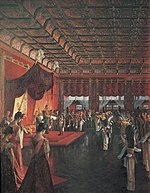 | Prince Shimazu Tadashige |
| 52 | Grand Parade to Celebrate the Constitution 憲法発布観兵式行幸啓 Kenpō happu kanpei shiki gyōkō kei | 11 February 1889 | Katata Tokurō (片多徳郎) (1889–1934) | February 1928 | after promulgation of the Meiji Constitution, the Emperor and Empress leave the Imperial Palace on their way to the Aoyama Parade Grounds (青山練兵場) for a military review | 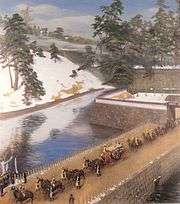 | Industrial Bank of Japan |
| 53 | Poetry Party at the Imperial Palace 歌御会始 Uta-gokai hajime | 18 January 1890 | Yamashita Shintarō (1881–1966) | December 1927 | held in the Phoenix Hall at the Imperial Palace, with poems composed on the topic of the celebration of national prosperity | .jpg) | Ministry of the Imperial Household |
| 54 | The Emperor at Joint Military Manoeuvres 陸海軍大演習御統監 Rikukaigun dai-enshū go-tōkan | 31 March 1890 | Nahahara Kōtarō (長原孝太郎) (1864–1930) | May 1931 | the Emperor watches from a hill near Nagoya during a rain storm | .jpg) | Nagoya City |
| 55 | The Imperial Rescript on Education 教育勅語下賜 Kyōiku chokugo kashi | 30 October 1890 | Ataka Yasugorō (安宅安五郎) (1883–1960) | November 1930 | Prime Minister Yamagata Aritomo (in front) and Minister of Education Yoshikawa Akimasa (behind) leave the Imperial Palace with the Rescript | 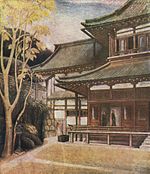 | Meikeikai (茗渓会) |
| 56 | Inauguration of the First Imperial Diet 帝国議会開院式臨御 Teikoku Gikai kaiin shiki ringyo | 29 November 1890 | Kosugi Misei (小杉未醒) (1881–1964) | September 1928 | Itō Hirobumi, Speaker of the House of Peers, receives the Emperor's message, while Speaker of the House of Representatives Nakajima Nobuyuki (中島信行) stands below | .jpg) | House of Peers, House of Representatives |
| 57 | Silver Wedding Anniversary of the Emperor 大婚二十五年祝典 Daikon nijūgo-nen shukuten | 9 March 1894 | Hasegawa Noboru (長谷川昇) (1886–1973) | June 1927 | a performance of traditional dances in the Imperial Palace | (not public domain until 2043) | Kazoku Kaikan |
| 58 | The Battle of Pyongyang 日清役平壌戦 Nisshin-eki Pyon'yan-sen | 15 September 1894 | Kanayama Heizō (金山平三) (1883–1964) | December 1933 | the Mixed Ninth Brigade, under General Ōshima Yoshimasa, in action, during the First Sino-Japanese War | .jpg) | Kobe City |
| 59 | The Battle of the Yellow Sea 日清役黄海海戦 Nisshin'eki Kō-kai kaisen | 27 September 1894 | Ōta Kijirō (太田喜二郎) (1883–1951) | July 1934 | the Japanese fleet, under Admiral Itō Sukeyuki, engages the Chinese | Ōsaka Shōsen Kabushiki gaisha (大阪商船株式会社) | |
| 60 | The Emperor at Imperial Headquarters 広島大本営軍務親裁 Hiroshima daihon'ei gunmu shinsai | 1895 | Minami Kunzō (南薫造) (1883–1950) | July 1928 | the Emperor as Supreme Commander is briefed by Vice-Chief of the General Staff Kawakami Sōroku at headquarters in Hiroshima | .jpg) | Marquis Asano Nagakoto |
| 61 | The Empress Visiting Wounded Soldiers 広島予備病院行啓 Hiroshima yobi byōin gyōkei | 22 March 1895 | Ishii Hakutei (1882–1958) | December 1929 | Empress Shōken visits the Army Auxiliary Hospital in Hiroshima | .jpg) | Japanese Association of Medical Sciences, Japan Medical Association |
| 62 | Peace Conference at Shimonoseki 下関講和談判 Shimonoseki kōwa danpan | 17 April 1895 | Nagatochi Hideta (永地秀太) (1873–1942) | Lying-in Chamber (御産室) | .jpg) | Shimonoseki City | |
| 63 | Restoration of Peace in Taiwan 台湾鎮定 Taiwan chintei | 11 June 1895 | Ishikawa Toraji (石川寅治) (1875–1964) | April 1928 | Prince Kitashirakawa Yoshihisa enters Taipei |  | Government-General of Taiwan |
| 64 | The Emperor at Yasukuni Shrine 靖国神社行幸 Yasukuni Jinja gyōkō | 17 December 1895 | Shimizu Yoshio (清水良雄) (1891–1954) | July 1929 | the Emperor ascends the stairs to honour those who fell in the First Sino-Japanese War | .jpg) | Daiichi Bank (第一銀行) |
| 65 | Shintenfu Hall 振天府 Shintenfu | March 1897 | Kawamura Kiyoo (1852–1934) | October 1931 | the hall was built in the grounds of the Imperial Palace to house items relating to the war, including photographs of all the officers and the names of all the dead | .jpg) | Prince Tokugawa Iesato |
| 66 | The Anglo-Japanese Treaty of Alliance 日英同盟 Nichiei dōmei | 12 December 1902 | Yamamoto Kanae (1882–1946) | October 1932 | Prime Minister Katsura Tarō reads the Treaty to the House of Peers | .jpg) | Bank of Korea |
| 67 | The Empress at a Red Cross Meeting 赤十字社総会行啓 Akajūji-sha sōkai gyōkei | 21 October 1902 | Yuasa Ichirō (湯浅一郎) (1869–1931) | July 1929 | Empress Shōken addresses the 11th General Meeting of the Japanese Red Cross Society in Ueno Park | .jpg) | Japanese Red Cross Society |
| 68 | Declaration of War with Russia 対露宣戦布告御前会議 tai-Ro sensen fukoku gozen kaigi | 4 February 1904 | Yoshida Shigeru (吉田苞) (1883–1953) | March 1934 | the Emperor, Prime Minister Katsura Tarō, elder statesman Itō Hirobumi, and others agree to the declaration of war with Russia at a Gozen Kaigi | Prince Matsukata Iwao (松方巌) | |
| 69 | The Surrender of Port Arthur 日露役旅順開城 Nichiro-eki ryojun kaijō | 5 January 1905 | Arai Rokuo (荒井陸男) (1885–1972) | October 1928 | General Anatoly Stessel presents his horse to General Nogi Maresuke in the village where the surrender was signed three days earlier | (not public domain until 2042) | Kwantung Government (関東庁) |
| 70 | The Battle of Mukden 日露役奉天戦 Nochiro-eki Hōten-sen | 15 March 1905 | Kanokogi Takeshirō (1874–1941) | October 1926 | General Ōyama Iwao and his staff enter the South Gate of Mukden, after the city fell on the 10th | .jpg) | South Machuria Railway Company |
| 71 | The Battle of the Japan Sea 日露役日本海海戦 Nichiro-eki Nihon-kai kaisen | 27 May 1905 | Nakamura Fusetsu (1866–1943) | October 1928 | Admiral Tōgō Heihachirō's flagship, the Mikasa, leads the Japanese fleet into action at the Battle of Tsushima | 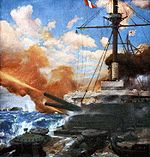 | Nippon Yusen Kabushiki gaisha |
| 72 | The Portsmouth Peace Conference ポーツマス講和談判 Pōtsumasu kōwa danpan | 5 September 1905 | Shirataki Ikunosuke (白滝幾之助) (1873–1960) | November 1931 | Komura Jutarō, Sergei Witte, and others sign the Treaty, bringing to an end the Russo-Japanese War | .jpg) | Yokohama Specie Bank |
| 73 | The Triumphal Grand Naval Review 凱旋観艦式 Gaisen kankan shiki | 23 October 1905 | Tōjō Shōtarō (東城鉦太郎) (1865–1929) | May 1929 | the Emperor aboard the Asama reviews the Combined Fleet in Yokohama Bay on 23 October 1905, with Commander-in-Chief Tōgō Heihachirō to his left and the future Taishō Emperor to his right, flanked in turn by Navy Minister Yamamoto Gonnohyōe and Chief of the Navy General Staff Itō Sukeyuki; over 160 vessels took part in the 1905 Triumphal Grand Review that celebrated the navy's contribution to victory in the Russo-Japanese War | 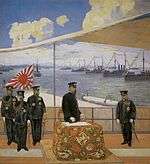 | Ministry of the Navy |
| 74 | The Triumphal Grand Army Review 凱旋観兵式 Gaisen kanbei shiki | 30 April 1906 | Kobayashi Mango (小林万吾) (1870–1947) | December 1931 | the Emperor reviews the troops at the Aoyama Parade Grounds (東京青山練兵場), with Ōyama Iwao riding behind | .jpg) | Ministry of the Army |
| 75 | Demarcation of the Sakhalin Frontier 樺太国境画定 Karafuto kokkyō kakutei | June 1906 | Yasuda Minoru (安田稔) (1881–1965) | December 1932 | Japanese and Russian representatives designate the boundary marker on the 50th parallel, after the Treaty of Portsmouth | .jpg) | Nippon Oil Kabushiki gaisha |
| 76 | The Chrysanthemum Garden Party 観菊会 Kangikukai | 19 November 1909 | Nakazawa Hiromitsu (中沢弘光) (1874–1964) | May 1931 | the Emperor and Empress attend the party at the Akasaka Palace for the first time | .jpg) | Marquis Tokugawa Yorisada (徳川頼貞) |
| 77 | The Union of Korea and Japan 日韓合邦 Nikkan gappō | 22 August 1910 | Tsuji Hisashi (辻永) (1884–1974) | October 1927 | depicted is the Namdaemun at the time of annexation | (not public domain until 2044) | The Provinces of Korea |
| 78 | The Emperor at Tokyo Imperial University 東京帝国大学行幸 Tōkyō Teikoku Daigaku gyōkō | 10 July 1912 | Fujishima Takeji (1867–1943) | April 1936 | the arrival of the Emperor for the graduation ceremonies | .jpg) | Marquis Maeda Toshinari |
| 79 | The Emperor's Final Illness 不豫 Fuyo | July 1912 | Tanabe Itaru (田辺至) (1886–1968) | March 1927 | as the Emperor's condition worsened, people gather outside the Tokyo Imperial Palace to pray for his recovery | Tōkyō Prefecture | |
| 80 | The Imperial Funeral 大葬 Taisō | 14 September 1912 | Wada Sanzō (1883–1967) | July 1933 | after a ceremony at the Aoyama Funeral Pavilion (青山葬場殿) in Tōkyō on 13 September, the Emperor's coffin was taken by train to Kyōto, before being conveyed to Fushimi Momoyama no Misasagi (伏見桃山陵) | .jpg) | Meiji Jingū Commemorative Association (明治神宮奉賛会) |
See also
References
| Wikimedia Commons has media related to Meiji Memorial Picture Gallery. |
- "Meiji Memorial Picture Gallery". Meiji Jingu Gaien. Retrieved 3 November 2015.
- 聖徳記念絵画館 [Meiji Memorial Picture Gallery] (in Japanese). Agency for Cultural Affairs. Retrieved 3 November 2015.
- Meiji Jingū Gaien, ed. (2001). 聖徳記念絵画館壁画 [Explanatory Notes on pictures in Memorial Picture Gallery, Meiji Jingū] (in Japanese).
- "MEIJIJINGU GAIEN|Meiji Memorial Picture Gallery". Meijijingugaien.jp. 1925-10-22. Retrieved 2019-03-20.
- "Meijijingu Gaien".
External links
- (in English) Meiji Memorial Picture Gallery
- (in Japanese) The Paintings